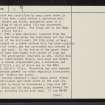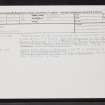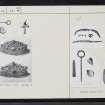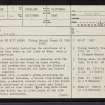Scheduled Maintenance
Please be advised that this website will undergo scheduled maintenance on the following dates: •
Tuesday 3rd December 11:00-15:00
During these times, some services may be temporarily unavailable. We apologise for any inconvenience this may cause.
Reay
Cemetery (Viking)(Possible)
Site Name Reay
Classification Cemetery (Viking)(Possible)
Canmore ID 7252
Site Number NC96NE 13
NGR NC 973 650
Datum OSGB36 - NGR
Permalink http://canmore.org.uk/site/7252
- Council Highland
- Parish Reay
- Former Region Highland
- Former District Caithness
- Former County Caithness
NC96NE 13 973 640.
(Name centred: NC 9737 6508) Viking Burial found AD 1926 (NAT)
OS 6" map, (1967)
Viking burials, probably indicating the existence of a cemetery, have been found on the links of Reay, usually exposed by sand-blow.
Viking Club 1912.
A: In 1912, probably in September, a skeleton with the buckle of a horse bridle was found by James Forbes, grave-digger and postman who, assisted by the District Inspector of the Poor, collected the bones and buried them in Reay cemetery.
B: In September 1913, a woman's grave, containing two 10th century tortoise brooches, a bronze ring-headed pin, a bronze buckle, a steatite spindle whorl, and iron bridle-bit, and the ankle-bone of a small horse was found. Aniron buckle and an iron cross, 1 5/8ins long were found soon afterwards within two or three yards of the site and were probably associated.
In 1926 the site was identified by many horse bones in the sand. It had been placed beside a dry-stone wall about 4ft in height and width, apparently part of a circular building of which about 12ft was uncovered, and shows above ground level. The finds are in the National Museum of Antiquities of Scotland (NMAS, Accession nos IL 335-9; 341-2)
C: In August 1926, a male skeleton, complete from the knees upwards, was found among the sand-dunes not far from the north side of the drill-hall (NC 9736 6504) at Reay. It lay full length on a paved surface with the head slightly raised on a flat stone, and was surrounded and covered by large stones and sand. In the bottom of the grave there was a layer of dark sand mixed with pieces of slag and burnt iron. The grave-goods comprised an axe, shield boss knife, sickle, cleat-shaped object, nail-head and buckle all of iron; a bronze ring-headed pin, a whetstone and two pieces of flint - all of which are in the NMAS (Accession nos. IL 365-371, 373-5) Wind-blow had also exposed traces of numerous graves 'or other regularly constructed works in stone' between the dunes.
D: In 1928, Edwards examined a small mound about 160yards west of the drill-hall and 22 yards north of the road (ie. c. NC 9720 6504) in which he discovered a long cist 8ft long, by 2ft broad and 2ft deep, unpaved, and except for some red clay, entirely filled with sand. It lay NE-SW and was covered by small boulders and sand. No grave goods were found. E: Also in 1928, Edwards discovered the remains of two long cists 6ft long by 2ft wide and 1 1/2ft deep, on the east side of the Isauld Burn, between it and the farm dyke The cists lay nearly E-W with the head and side stones protruding above ground level. No grave goods were found, both cists being completely filled with earth.
D & E were discovered by Edwards during a search for further Viking burials, but beyond their form there is nothing to indicate that they were Viking.
J Curle 1914; A J H Edwards 1927; A J H Edwards 1929; A O Curle, M Olsen and H Shetelig 1954.
None of the cists, structures, nor the mound of 'D' are visible. No further information.
Visited by OS (N K B) 25 November 1964.
No change to the previous field report.
Visited by OS (J B) 8 September 1981.
















